Television Articles
KPLR History
KPLR-TV was founded by Harold Koplar, owner of St. Louis’ famed Chase Park Plaza Hotel. (Per FCC regulations, radio and TV stations east of the Mississippi have call letters that begin with the letter “W.” All stations west of the Mississippi have call letters beginning with “K.”) Our call letters, KPLR, represent the Koplar family name without the vowels.
Harold Koplar signed his new station on the air on April 28, 1959 with the first-ever live telecast of a Cardinal Baseball game in the St. Louis area. (This is disputable. Ed.)
KPLR was the first VHF independent station in St. Louis, located for 40 years in the Central West End at 4935 Lindell Boulevard – next to the Chase Park Plaza Hotel.
Edward J. (Ted) Koplar, Harold’s son, became a full-time employee in the mid-1960s and soon after developed KPLR’s first newscast. Within three years after its inception, “KPLR Newswatch” was the number one rated Independent television newscast in the country.
Ted was named President, Koplar Communications in April 1979. The company continued to grow and expand its tradition of innovation in programming and technology.
KPLR installed a satellite receive dish (completed in 1976) making KPLR the first broadcast facility in the county licensed by the FCC to own and operate a satellite earth station.
In 1983, the station installed the area’s first and only satellite uplink transmission facility making KPLR one of the busiest teleports in the Midwest for news and sports transmissions.
In 1984, KPLR became the first station in St. Louis and one of the first in the country to convert to full stereo sound.
One of the most important days for our history occurred in 1988 when Ted Koplar headed the effort to win back exclusive rights to telecast St. Louis Cardinals Baseball on KPLR. This put us back on the map as a strong and major player in the marketplace!
KPLR was one of the original “charter” members of the WB Network headed by Jamie Kellner. The WB did whatever they could to secure KPLR – not because KPLR needed the affiliation, but because the WB needed a strong station that brought with it a rich and credible history. In January 1995, the WB officially “launched” the network and KPLR soon became known as their “crown jewel.” KPLR’s network affiliation basically involved prime programming with shows primarily targeted to young adults and ethnic audiences.
ACME Television Holdings, also created by Jamie Kellner, purchased KPLR in 1977. So after a history of family ownership, KPLR moved into the future as a privately held company. By this time, KPLR was recognized as one of the top WB affiliates in the nation. (During that era we usually ranked as the #1 WB affiliate but never dropped under one of the top three.)
In March, 2003, Tribune purchased KPLR to add to the strength of their television empire. It was under this new ownership and umbrella that the CW Television Network launched its 2006 inaugural television season. “The New CW” featured a mixture of programming from both the UPN and The WB television networks, The CW was no more than a joint venture between CBS Corporation, owner of UPN, and Warner Bros. Entertainment, a subsidiary of Time Warner, majority owner of the WB. Its name derived from the first letter of the names of these two giants (CBS and Warner Bros.) In trade magazines like Variety, the CW is referred to as the green network, most likely since its first logos and campaigns were in green.
In 2007 Sam Zell agreed to take Tribune private in an $8.2 billion deal that values the company at $13 billion.
(Provided by KPLR)
 hostess of “Open House,” appreciates the dilemma of being both housewife and mother. Her 3-year old Jimmy clamors for his share of her attention as she prepares her program every week. But like many an other “working mother” she must arrange her work and time so that all phases of the homemaker’s task plus job is(sic) adequately handled.
hostess of “Open House,” appreciates the dilemma of being both housewife and mother. Her 3-year old Jimmy clamors for his share of her attention as she prepares her program every week. But like many an other “working mother” she must arrange her work and time so that all phases of the homemaker’s task plus job is(sic) adequately handled.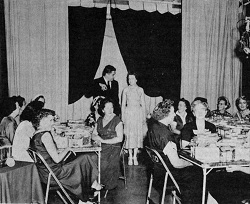 In a recent poll by TV Review “To The Ladies” was voted the number one local show by an overwhelming majority. This is not hard to realize when you meet the people who produce and perform on the show. Here’s our formula for a lunch hour treat. Find a place to eat with a television set and watch “To The Ladies” while you eat. It’s a relaxing and entertaining way of enjoying lunch.
In a recent poll by TV Review “To The Ladies” was voted the number one local show by an overwhelming majority. This is not hard to realize when you meet the people who produce and perform on the show. Here’s our formula for a lunch hour treat. Find a place to eat with a television set and watch “To The Ladies” while you eat. It’s a relaxing and entertaining way of enjoying lunch. Harry is a likable fellow, with a ready wit and a hearty desire for fun and sociability. A graduate of St. Louis University, where he minored in Radio Broadcasting, he now majors in Television for his bread and butter. After school Harry gained experience in various capacities, such as radio staff announcer, and his Market Basket Quiz over KSD. He entered television by the side door, his first job as a TV commercial salesman branched into his first appearance on Television in the program named “Just Make It Music.” Other shows followed such as “Pedro” on the “Dodge Talent Parade” and the Hyde Park Show.
Harry is a likable fellow, with a ready wit and a hearty desire for fun and sociability. A graduate of St. Louis University, where he minored in Radio Broadcasting, he now majors in Television for his bread and butter. After school Harry gained experience in various capacities, such as radio staff announcer, and his Market Basket Quiz over KSD. He entered television by the side door, his first job as a TV commercial salesman branched into his first appearance on Television in the program named “Just Make It Music.” Other shows followed such as “Pedro” on the “Dodge Talent Parade” and the Hyde Park Show.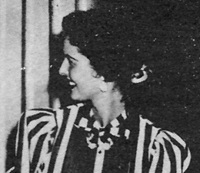 Today Harry holds the top spot on the No. 1 local TV show in the St. Louis area. He’s earned it all the way as our Harry Honig fan mail will testify, No TV show is complete without a secretary, so let’s go see Frankie, as she is known affectionately to her friends. (I don’t see how she could have any enemies.) Now Frankie’s full name is Frankie Lee Helms, a graduate of Central High, with a background of fashion modeling for Harper’s, Vogue and Mademoiselle. Her current position as secretary handling production scheduling, playing hostess to twenty ladies five days a week, and good will ambassador to visiting celebrities has her pleased as punch, and her interest in her job has her putting her best foot forward. Occasionally she does a bit of the commercial on “To The Ladies.” Born in Virginia, she makes a lovely and charming ambassador from the south.
Today Harry holds the top spot on the No. 1 local TV show in the St. Louis area. He’s earned it all the way as our Harry Honig fan mail will testify, No TV show is complete without a secretary, so let’s go see Frankie, as she is known affectionately to her friends. (I don’t see how she could have any enemies.) Now Frankie’s full name is Frankie Lee Helms, a graduate of Central High, with a background of fashion modeling for Harper’s, Vogue and Mademoiselle. Her current position as secretary handling production scheduling, playing hostess to twenty ladies five days a week, and good will ambassador to visiting celebrities has her pleased as punch, and her interest in her job has her putting her best foot forward. Occasionally she does a bit of the commercial on “To The Ladies.” Born in Virginia, she makes a lovely and charming ambassador from the south.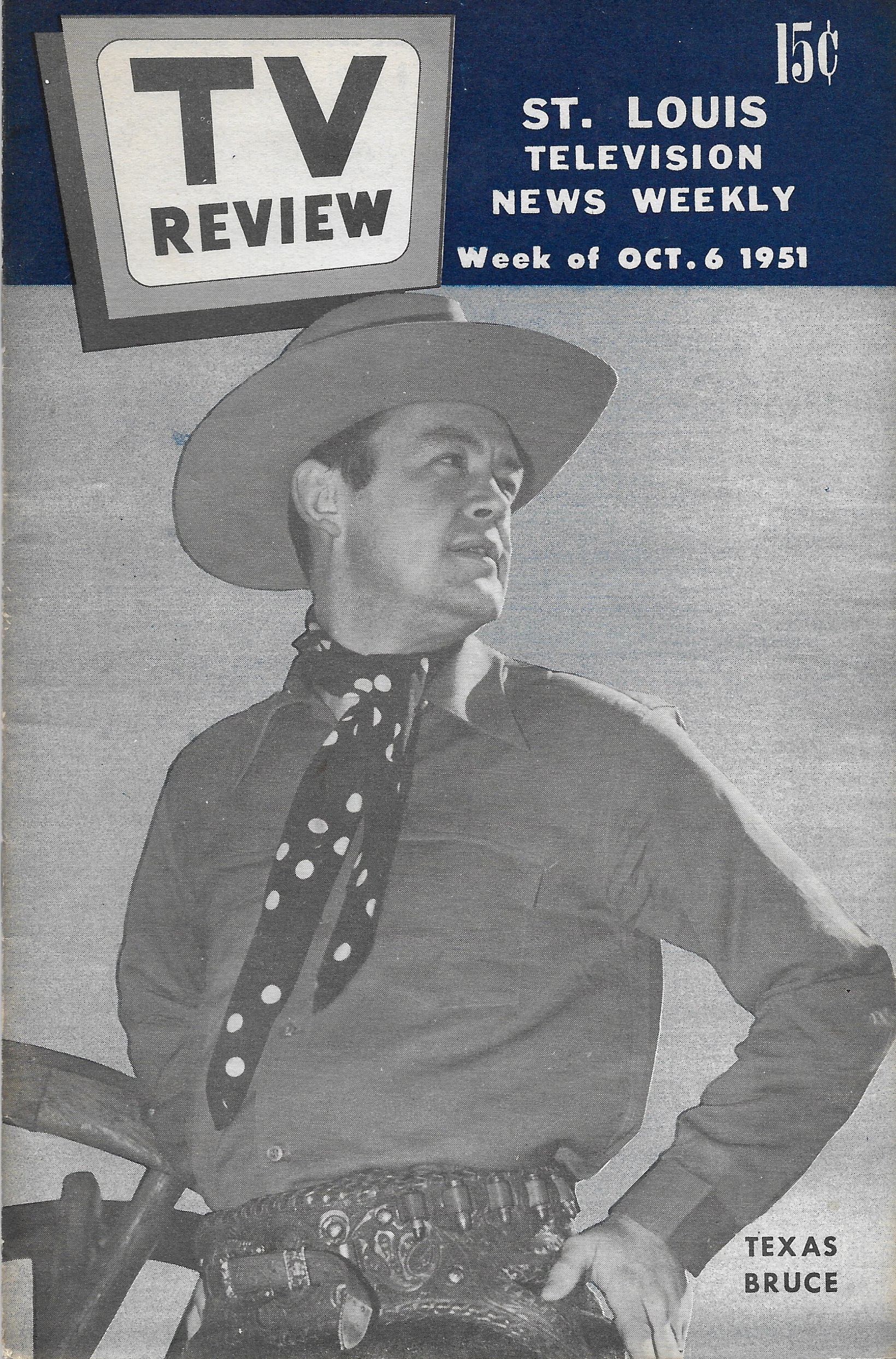 As far as kids in and around St. Louis are concerned, this guy Hopalong is strictly a second-rater. When it comes to choosing cowboys, they’ll put all their dinero (that’s money, pardner) on St. Louis’ own cowhand, Texas Bruce, who conducts a daily fifteen minute yarnin’ session known as “The Wranglers Club.” Harry Gibbs is the fellow’s check-signing name, but to his many wranglers, he’s known as “Texas Bruce” and, in their opinion, what he has to say about Western lore is law.
As far as kids in and around St. Louis are concerned, this guy Hopalong is strictly a second-rater. When it comes to choosing cowboys, they’ll put all their dinero (that’s money, pardner) on St. Louis’ own cowhand, Texas Bruce, who conducts a daily fifteen minute yarnin’ session known as “The Wranglers Club.” Harry Gibbs is the fellow’s check-signing name, but to his many wranglers, he’s known as “Texas Bruce” and, in their opinion, what he has to say about Western lore is law.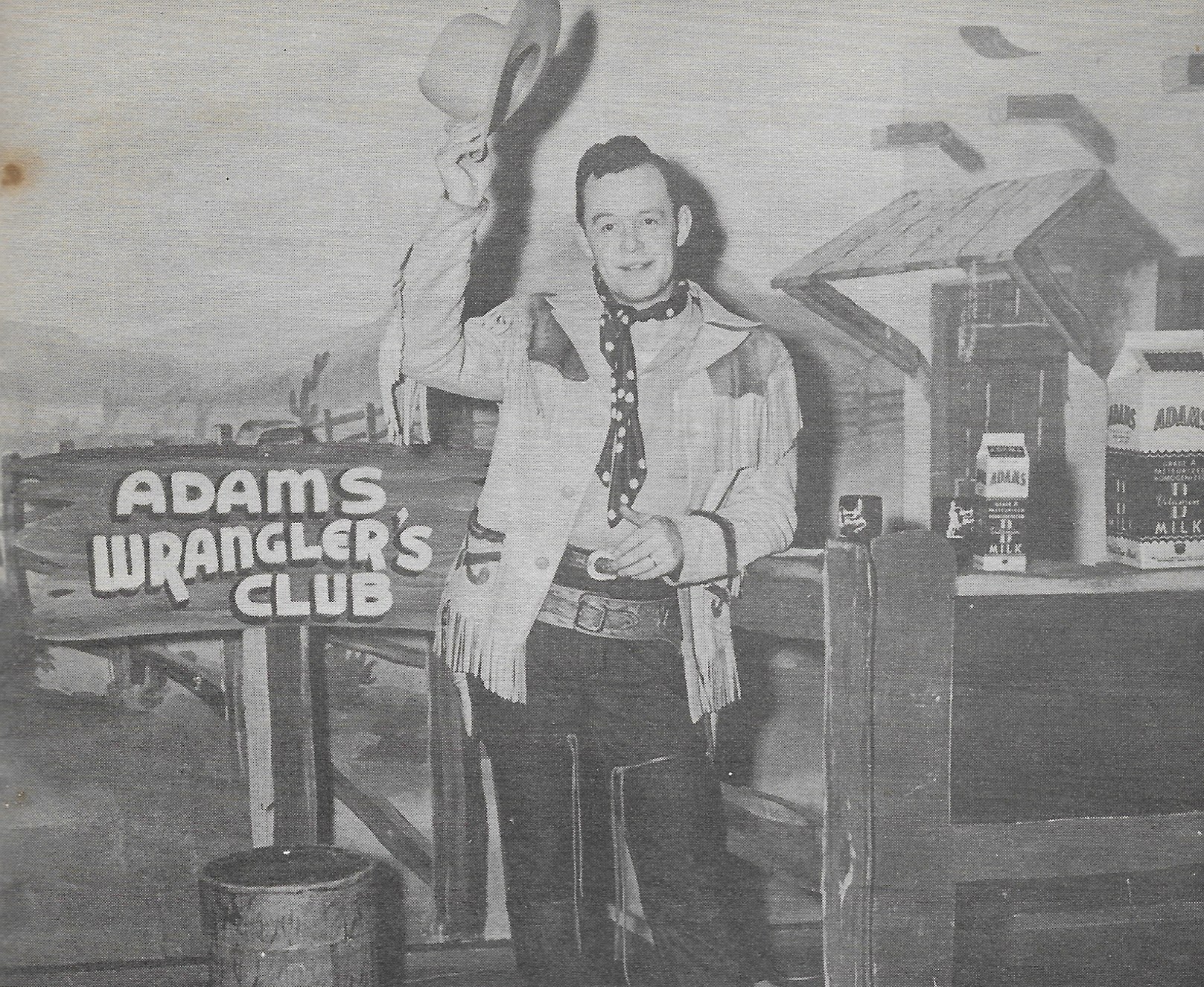 Gibbs is often called upon to perform before various organizations such as the Boy Scouts, Cub Scouts, and groups of underprivileged children, as well as taking part in benefit shows of all worthwhile civic undertakings.
Gibbs is often called upon to perform before various organizations such as the Boy Scouts, Cub Scouts, and groups of underprivileged children, as well as taking part in benefit shows of all worthwhile civic undertakings.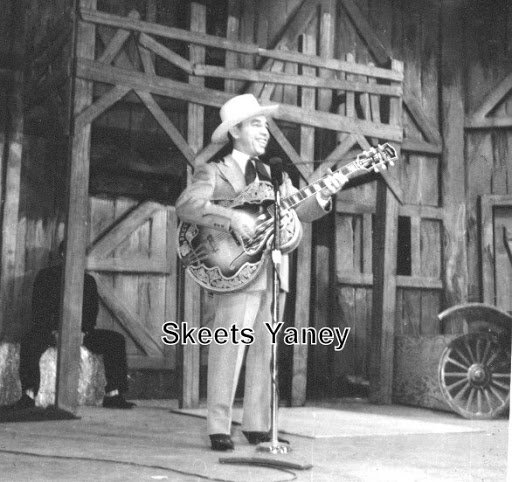 Who said New York and Hollywood has (sic) all the talent? Just to prove a point tune in on the Ozark Barn Dance every Friday at 8:30 p.m. over TV station KACY – Channel 14, and you will be entertained by local talent of network quality. Even the set which forms the background for this show is so original, so complete and so big that one can almost smell the invigorating odor of fresh-mown hay. Skeets Yaney, originator and MC of this show, is one of the most amiable and friendly sort of entertainers (he is just as likeable off the show as in front of the cameras). It is a pleasure to watch as he performs on his guitar with or without vocal arrangements, and his direction of the show is so natural you get the feeling that you are just as much a part of it as he is. But that isn’t all. Skeets has gathered a group of people that are so likeable, homey and down to earth that everyone in the family will find equal enjoyment in such entertainment, as he presents “The Range Riders,” a trio consisting of Roland Gaines and Shorty Mason, who sing as well as play their guitars, and Wally Proctor with his electric guitar as well as vocalizing. By the way, Wally plays a left-handed guitar. (If you don’t believe it, watch him on the show.) Now meet Tommy Watson, a triple-threat man with a trumpet, a fiddle or a banjo; next, Frank Krajir, the accordianist, and Eddie Burke, bass fiddler. Frank can really tickle that accordian and Eddie is a very accomplished musician. Of course the fair sex hasn’t been left out and the love and beauty interest is supplied by pretty Linda Fields, the featured vocalist. Another standout vocalist should be mentioned here and that is little Larry Keith. He’s only about six or seven years old, but how you’ll get to love that smile – and he smiles while he sings – and he can sing. Try it sometime and you’ll see how hard it is to keep a smile on your face while singing. Every once in a while when Larry’s singing, he gazes around like any other youngster would, Skeets would call his attention to the camera and boy, you should see him break out in his best smile.
Who said New York and Hollywood has (sic) all the talent? Just to prove a point tune in on the Ozark Barn Dance every Friday at 8:30 p.m. over TV station KACY – Channel 14, and you will be entertained by local talent of network quality. Even the set which forms the background for this show is so original, so complete and so big that one can almost smell the invigorating odor of fresh-mown hay. Skeets Yaney, originator and MC of this show, is one of the most amiable and friendly sort of entertainers (he is just as likeable off the show as in front of the cameras). It is a pleasure to watch as he performs on his guitar with or without vocal arrangements, and his direction of the show is so natural you get the feeling that you are just as much a part of it as he is. But that isn’t all. Skeets has gathered a group of people that are so likeable, homey and down to earth that everyone in the family will find equal enjoyment in such entertainment, as he presents “The Range Riders,” a trio consisting of Roland Gaines and Shorty Mason, who sing as well as play their guitars, and Wally Proctor with his electric guitar as well as vocalizing. By the way, Wally plays a left-handed guitar. (If you don’t believe it, watch him on the show.) Now meet Tommy Watson, a triple-threat man with a trumpet, a fiddle or a banjo; next, Frank Krajir, the accordianist, and Eddie Burke, bass fiddler. Frank can really tickle that accordian and Eddie is a very accomplished musician. Of course the fair sex hasn’t been left out and the love and beauty interest is supplied by pretty Linda Fields, the featured vocalist. Another standout vocalist should be mentioned here and that is little Larry Keith. He’s only about six or seven years old, but how you’ll get to love that smile – and he smiles while he sings – and he can sing. Try it sometime and you’ll see how hard it is to keep a smile on your face while singing. Every once in a while when Larry’s singing, he gazes around like any other youngster would, Skeets would call his attention to the camera and boy, you should see him break out in his best smile.